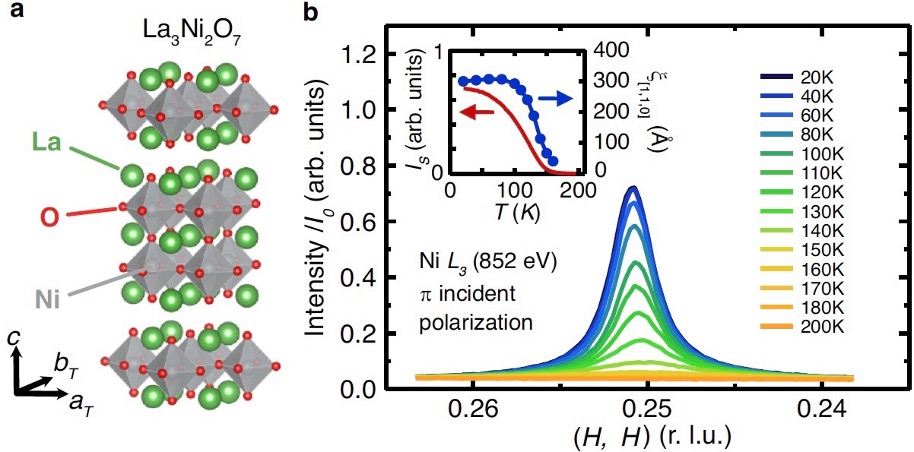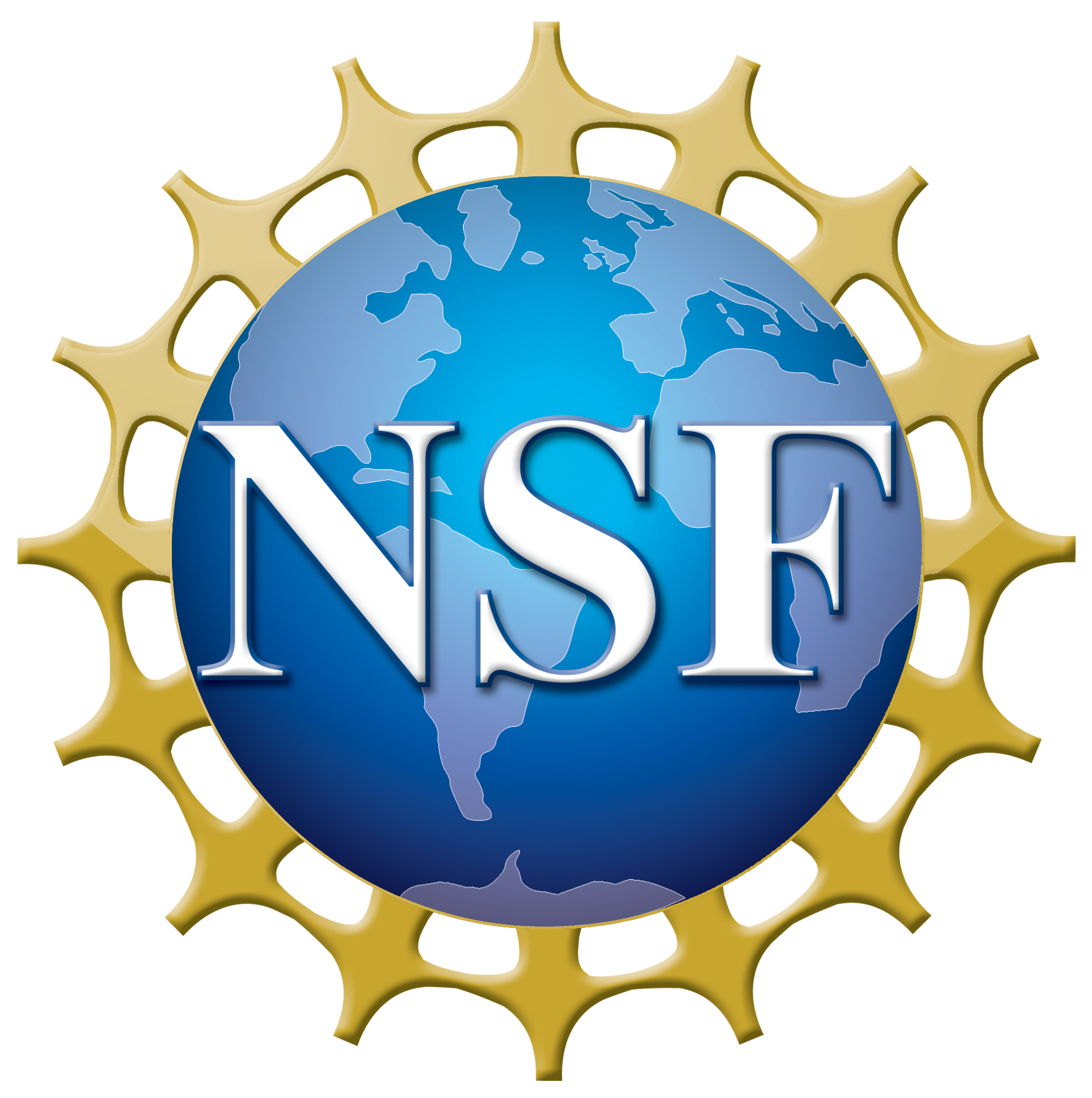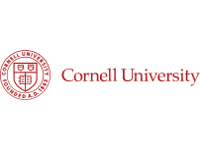PARADIM Highlight #112—In-House Research (2025)
K.M. Shen, A. Singer, D.G. Schlom (Cornell) & D.G. Hawthorn (Waterloo)
Superconductivity is the ability to conduct electricity with zero resistance but commonly requires ultralow temperatures. The recent finding of superconductivity in La3Ni2O7 with a transition temperature above 80 K when under high pressure ignited intense interest in understanding the common ingredients and mechanism that are essential for enabling superconductivity at high temperatures. A spin density wave (SDW) state could be the common denominator of the required pairing interaction.

Figure 1. Magnetic Resonant Scattering and X-Ray Absorption of La3Ni2O7. a) The crystal structure of La3Ni2O7, with the pseudo tetragonal axes aT and bT denoting the in-plane NiO bond directions. b) The intensity (scattering + background) for cuts along the (H, H, 1.86) direction through the SDW peak at various temperatures, measured at the Ni L3 absorption edge with π incident polarization for sample A. Inset: SDW peak amplitude (red) and correlation length along the [1 1 0] direction (blue) as a function of temperature.
Here, members of the PARADIM In-House Research Team and collaborators use resonant soft x-ray scattering and polarimetry on thin films of La3Ni2O7 (see figure for its crystal structure) to determine the magnetic structure of the SDW. Highly elongated, stripe-shaped domains of charge density were discerned. Analogous features are seen in other high-temperature superconductors, making them the common feature in this rare class of quantum materials.
The discovery of superconductivity in La3Ni2O7 under pressure has motivated the investigation of a parent spin density wave (SDW) state, which could provide the underlying pairing interaction. Here, we employ resonant soft x-ray scattering and polarimetry on thin films of bilayer La3Ni2O7 to determine that the magnetic structure of the SDW forms unidirectional diagonal spin stripes with moments lying within the NiO2 plane and perpendicular to QSDW, but without evidence of the strong charge disproportionation typically associated with other nickelates. These stripes form anisotropic domains with shorter correlation lengths perpendicular versus parallel to QSDW, revealing nanoscale rotational and translational symmetry breaking analogous to the cuprate and Fe-based superconductors, with possible Bloch-like antiferromagnetic domain walls separating orthogonal domains.
Several distinct families of high-temperature superconductors are known: the cuprates, the pnictides, and most recently the nickelates. High-Tc superconductivity is an exceedingly rare and potentially useful quantum state but understanding it to the point that even higher Tc compounds can be predicted and reduced to practice has not happened despite nearly 40 years of research. This work identifies a common ingredient in all classes of high-Tc superconductors: an antiferromagnetic spin density wave parent state. This antiferromagnetic parent state likely provides the “pairing glue” for high-Tc superconductivity, but how?
PARADIM’s In-House research team has perfected ways to make nickelate superconductors with improved perfection, enabling their intrinsic properties to be studied. Often “dirt effects” due to unwanted impurity phases or disorder can hide the key spectroscopic features of a material. Cleaner materials lead to better spectroscopy and better understanding, especially of emerging quantum materials like the superconducting nickelates.
N.K. Gupta, R. Gong, Y. Wu, M. Kang, C.T. Parzyck, B.Z. Gregory, N. Costa, R. Sutarto, S. Sarker, A. Singer, D.G. Schlom, K.M. Shen, and D.G. Hawthorn, "Anisotropic Spin Stripe Domains in Bilayer La3Ni2O7," Nat. Commun. 16, 6560 (2025).
This work was primarily supported by the National Science Foundation through Grant No. DMR-2104427 (K.M.S.), the Air Force Office of Scientific Research (Grant No. FA955021−1-0168, FA9550-23−1-0161; K.M.S.) and the Natural Sciences and Engineering Research Council (NSERC) of Canada (D.G.H.). The Platform for the Accelerated Realization, Analysis and Discovery of Interface Materials (PARADIM) under Cooperative Agreement No. DMR-2039380 supported optimization of film growth parameters and structural characterization (D.G.S. and K.M.S.). The U.S. Department of Energy, Office of Basic Energy Sciences under contract no. DE-SC0019414 (B.Z.G, A.S., D.G.S., K.M.S.) supported the hard x-ray synchrotron diffraction work at CHEXS. Additional support for materials synthesis was provided by the Gordon and Betty Moore Foundation’s EPiQS Initiative through Grant Nos. GBMF3850 and GBMF9073 (D.G.S.). N.K.G. acknowledges support from the Waterloo Institute of Nanotechnology (WIN). This work is based on research conducted at the Center for High-Energy X-ray Sciences (CHEXS), which is supported by the National Science Foundation (BIO, ENG and MPS Directorates) under award DMR-1829070. Part of the research described in this paper was performed at the Canadian Light Source, a national research facility of the University of Saskatchewan, which is supported by the Canada Foundation for Innovation (CFI), the Natural Sciences and Engineering Research Council (NSERC), the National Research Council Canada (NRC), the Canadian Institutes of Health Research (CIHR), the Government of Saskatchewan, and the University of Saskatchewan. Substrate preparation was performed in part at the Cornell NanoScale Facility, a member of the National Nanotechnology Coordinated Infrastructure, which is supported by the NSF (Grant No. NNCI-2025233); the authors would like to thank Sean Palmer and Steven Button for their assistance in substrate preparation and Michel Gingras for discussions.







